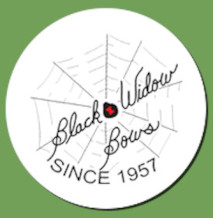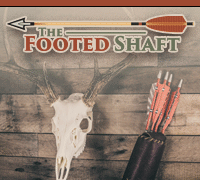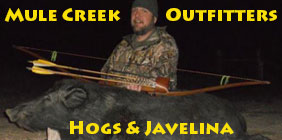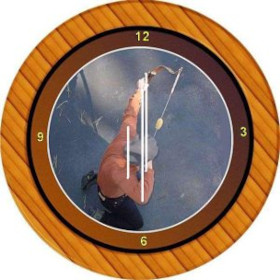Here's a good bit of info...
By C.J. Winand
DEER PELLETOLOGY
It has happened to every hunter at least once in their lifetime. It's a special feeling you get, when the deep trenches of your bowels signal you that the last bean burrito you ate from the night before hasn't been sitting too well. To confound the problem, you have been constipated for a week and now, all the pain in the world hits you at 7:00 AM in your favorite tree stand. By this time, I'm sure you know what I'm talking about; it goes by different names such as dump, do-do, crap, Number 2, leaving a deposit, pinching off a loaf, defecation, etc.
Since you're already 20 feet in the air, you have one of two major decisions to make. One, you could climb down from your tree stand and walk to a discrete place and do your business or two, in those real stressful situations, you could squat down over your stand and wait for relief to come.
A problem develops if you're 20 feet in the air and you realize there isn't any toilet paper, and all the leaves are on the ground or too far to reach. Instead of panicking, you find a solution to your problem by getting out your trusty Gerber knife and cutting off the tops of your socks. Or for those multiple wipe episodes, you can always tear the pocket off your T-shirt.
Most every hunter has gone through something like this and, believe it or not, this has actually happened (many times) to my good friend, Tony Canami. Tony is one of those guys who has left his mark in every parcel of woods for a 50-mile radius in Harford County, Maryland. You always know Tony was in the woods by the number of cut off Nike socks. Since Tony hunts almost every day, hunters in his area can tell where the hot spots are by the number of "used" socks.
One day, Tony and I were discussing all the "science" concerning deer feces and what it can mean to hunters. Unlike the opening paragraphs, the balance of this article will focus on the art and science of deer pelletology from a biological point of view. Needless to say, this article will be full of it!
What do droppings tell you?
1. Poop Texture can tell you what deer are eating
Many hunters are probably saying to themselves, "What can I learn from a bunch of deer droppings?", "Can we actually get closer to deer by learning something about deer pellets?", "Do all deer defecate in the same area?" or "Are buck droppings larger than does?" Surprisingly enough, all of these questions have been answered within the scientific community.
Whenever we come across a pile of droppings, the shape can give hunters many clues as to what the deer have been eating. Generally, the round individual droppings indicate deer have been eating leaves, browse and twigs. Whereas, the lumped (all-in-one) droppings tell hunters deer have been eating grasses and forbs. Whenever your hunting in a feeding area and see lots of lumped droppings, you should look for the closest grasses to key in on. Vice versa, if a hunter identifies many round or individual droppings it would not be best to hunt a food plot with cool season grasses.
Round, individual droppings incate deer have been eating browse such as leaves, twigs, and acorns.
Lumpy droppings indicate softer to digest; grasses, clover, alfalfa, apples, and other forbs.
Many hunters have tried to say they can tell the sex of the deer from the size of individual droppings. I can only think of the time when my dad rounded up all us boys and tried to find out who forgot to flush the commode. We all admittedly denied the very large, floating logs and shortly, found out the guilty party... none other than our good ole' mom.
Although this example may be going too far, work within deer pens would also point to the fact that the average hunter can not identify does from bucks through their droppings. In fact, some of my trophy deer droppings have come from penned does. An exception to this occurs when you have older aged bucks in your area. But, considering that most of the country supports very young bucks, "betting the farm" wouldn't be in order.
Way back in 1940, researcher Logan Bennett came up with an idea that is still used in today's deer management. He found that deer defecate 13 times per day. That's right, count'em, 13 times. It's no wonder why, hunters can actually smell deer! And if your wondering if those large piles are from bucks, biologists have found that some adult bucks may, in fact, produce more pellets per group. Biologists have also found that 75 is the average number of pellets per group (can you imagine the poor soul who had to count through all those samples). So, the next time you wonder onto a Boone and Crockett poop pile, you just might be a short distance "behind" a deer of a lifetime.
We read this article and decided to do our own investigation. We found a fresh pile of droppings and doug down through the leaves until we found em all. We then bagged them and counted each one. The total was 94.
2. Poop counts can tell you how many deer are in the area
What does this information have to do with hunting? Well, one of the questions hunters always ask biologists is "How many deer are there in this area?" The answer can be found in the number of droppings in the area. Bennett and other biologists determined the defecation rate for deer by simply walking various transects along an one square mile area and counting every pile of "woodland nuggets". Hunters can easily do the same and would be advised to conduct this population index every 24 hours after a snowfall. For example; if, after one day, you count 169 droppings along your transects, simply divide by 13. The density of deer within your hunting area is 13 deer per square mile. As with any population index the more times you sample your area the more accurate your results.
Other researchers have found that deer may average more piles of dung in the spring and fall. This is probably due to the increasing amounts of fiber added to the bulk feces between spring and fall. Evidently, as the diet changes from succulent leaves and forbs in spring to mature vegetation in summer to courser items in fall after leaf-drop, the number of pellet groups increase. Other data has found that defecation rates among adults and juveniles also differ with diet. Researcher Ryel found that bucks may have a higher defecation rate then does in winter.
3. Poop location can tell you where the deer are feeding and bedding
What else can research tell us about a bunch of droppings? One very important field clue is the approximate location of where the deer are feeding and bedding. Just like many people, shortly after a good meal they're off to the "reading room". Furthermore, I'll also bet the first thing you did this morning was head to the bathroom! Whenever you find a clumped distribution of droppings, you are in very close proximity to one of two areas...the feeding or bedding area. Since bedding areas are always hard to locate and you don't want to push deer from their beds, feces can be a great asset to their location.
Another field clue we can identify from pellets is what the deer are eating. With a little practice you would be amazed as to what you can identify. In fact, by picking through the various "specimens", hunters can readily determine a deer's feeding habits. Since your already picking through them, I might suggest rolling and/or rubbing around in them? I better repeat this...that's right, rub them all over your body. Before you think this is nuts, please hear me out.
Did you ever wonder why a dog will roll all over a dead rabbit or opossum? Instinctively, if he can cover his predator scent with that of another prey species he will become a more efficient predator. Just like hunters stepping in cow manure or by rolling or rubbing deer pellets onto your person and tree stand, you can effectively cover up some of your predator odors. Since droppings are located almost everywhere and they're FREE, hunters could not ask for a better cover scent.
To prove this point, myself and another biologist took dropping from one deer pen and placed them on the ground of another pen of totally distinct deer. The results were very interesting. The typical response included a monarch doe and her fawns coming over to investigate the strange droppings, smelling them and simply continuing on with their feeding without becoming alarmed. Obviously, our next test was on wild, free-ranging deer. Just like the penned deer, the wild deer checked out the unfamiliar odor, but did not become alarmed. Originally, we hypothesized that since penned and wild deer were socially use to all other deer within the herd, a foreign deer might cause some degree of alarm to the investigating deer. This definitely was not the case. We also wondered, what if we used urine and feces from other species.
Before we could actually test our hypothesis, I came upon an actual "feces thesis" done by researcher Howard Steinberg. Steinberg tested the response from deer towards feces from other herbivores (vegetation feeders), omnivores (both vegetation and meat eaters) and carnivores (meat eaters). He found that deer had the greatest aversion toward carnivores such as timber wolf, dog, bobcat and cougar. Interestingly enough, no matter how many times the carnivore samples were presented, the deer never became accustomed to it. But what about the other samples? Deer exhibited some aversion to the omnivores, but not as much as the carnivores and hardly any voidness to the herbivores.
What should surprise you, was that other deer droppings exhibited the greatest amount of interest from his study animals. Whenever you hunt one area, a good idea is to collect those special little woodland nuggets in a plastic bag and use in a different hunting area. Since deer are generally curious animals, using pellets from one area could be the final trick you need to bag your deer. Using deer droppings as a cover and attractant scent should now make a little more sense.
Furthermore, I would be neglectful in my duties if I didn't inform you that those woodland nuggets keep quite well in your freezer. Some may think this article is ridiculous, but the science of deer pelletology can indeed, help many hunters key in on many aspects of deer movements and patterns. And last, but not least, I might as well say it; if you're thinking I'm a 6-foot tall, 210 pound "turd", hanging some 20 feet up in a tree stand, your literally right!
C.J. Winand is a whitetail biologist from Randallstown, MD. He is a staff writer for Bowhunter as well as Deer and Deer Hunting Magazine.














